I was reading about Byzantine armor and have a question about the kresamata. Nicolle reckons that it is a green quilted skirt that protected the thighs while a separate set of ptyruges hung from the lamellar corselet over the top. Other sources say that the ptyruges hung from the underpadding and that THEY were the kresamata (there is no green padded skirt at all). I was wondering which is more likely to be correct. Personally I don't think that ptyruges were hung from the lamellar. They are more likely to be attached to the underpadding (kavanion).
Hi Dan,
In earlier usage flexible body armour which might be a padded arming coat worn in lieu of solid armour, or a shirt of mail or scales.
By the 10th century it had been supplanted by consistent use of more specific terms - kavadion and had come to
mean mail pieces used to supplement more solid armour, usually for cavalry.
The characteristic Byzantine lamellar cuirass, usually sleeveless. In addition, pteruges (leather hanging strips) were worn to protect shoulders and hips.
In an 11th-century fresco in the Church of Hasan Dagi,Kappadokhia. St George wears a klivanion of lamellar running continuously down onto his thighs rather than ending at the hips, and so unmistakably made for an infantryman. The sleeves of his padded under garment emerging from the sleeves of the klivanion.
This warrior saint carved in ivory is shown to be a foot soldier by his tear-drop shield and the lack of a division in his padded skirt. It is particularly interesting to note his tubular lower leg defences, and the cowl of his mail coif under the cloak. The cloth tied around his armour (called pektorarion) was a badge of rank. They must have been colour coded in some way, but unfortunately none of the sources record how. (Vatopedi Monastery, Mount Athos)
We only know that the color red was for the Byzantines a symbol of power.
If klivanion was worn by foot soldier, I think that ptyruges were not a separate set, but attached to klivanion. If worn by a knight, was likely to be separated.
kresamata: A quilted, green skirt hanging below a soldier's cuirass to protect his legs. Regarding kresamata, only one was found, the color we can gather only from fresco, example: Hosios Loukas in Greece.
At court all the men of a particular rank or function wore tunics of the same colour, and, while this is not mentioned in the sources, it is likely that in the centralized supply of tagmatic units this paradigm was followed, especially in view of their occasional appearance in imperial ceremonies.
Below is a reconstruction. It is inside part. Here will set strip-steel and ptyruges.
This is all I know, I hope it is helpful.
 Attachment: 177.11 KB
Attachment: 177.11 KB
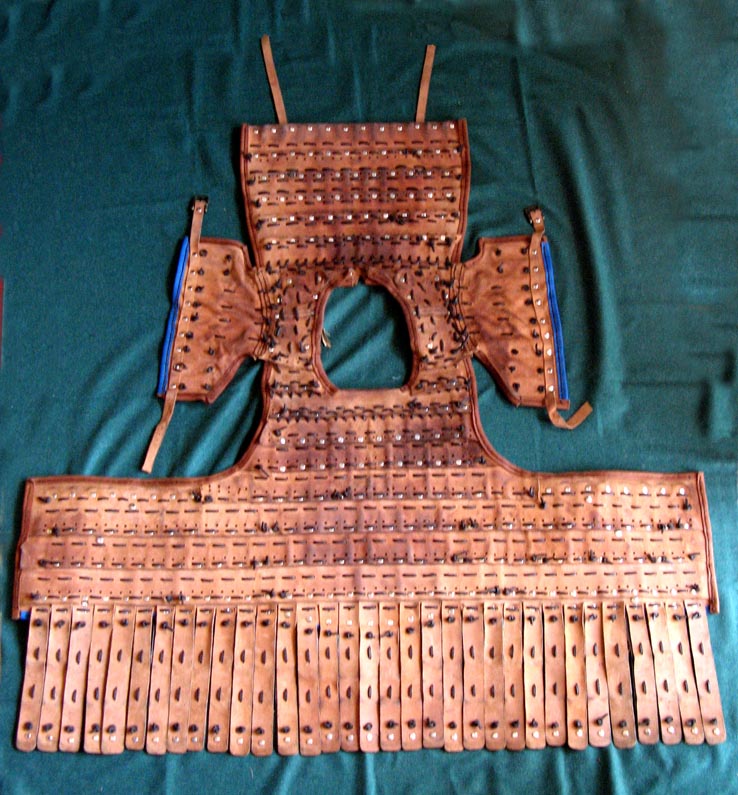
In earlier usage flexible body armour which might be a padded arming coat worn in lieu of solid armour, or a shirt of mail or scales.
By the 10th century it had been supplanted by consistent use of more specific terms - kavadion and had come to
mean mail pieces used to supplement more solid armour, usually for cavalry.
The characteristic Byzantine lamellar cuirass, usually sleeveless. In addition, pteruges (leather hanging strips) were worn to protect shoulders and hips.
In an 11th-century fresco in the Church of Hasan Dagi,Kappadokhia. St George wears a klivanion of lamellar running continuously down onto his thighs rather than ending at the hips, and so unmistakably made for an infantryman. The sleeves of his padded under garment emerging from the sleeves of the klivanion.
This warrior saint carved in ivory is shown to be a foot soldier by his tear-drop shield and the lack of a division in his padded skirt. It is particularly interesting to note his tubular lower leg defences, and the cowl of his mail coif under the cloak. The cloth tied around his armour (called pektorarion) was a badge of rank. They must have been colour coded in some way, but unfortunately none of the sources record how. (Vatopedi Monastery, Mount Athos)
We only know that the color red was for the Byzantines a symbol of power.
If klivanion was worn by foot soldier, I think that ptyruges were not a separate set, but attached to klivanion. If worn by a knight, was likely to be separated.
kresamata: A quilted, green skirt hanging below a soldier's cuirass to protect his legs. Regarding kresamata, only one was found, the color we can gather only from fresco, example: Hosios Loukas in Greece.
At court all the men of a particular rank or function wore tunics of the same colour, and, while this is not mentioned in the sources, it is likely that in the centralized supply of tagmatic units this paradigm was followed, especially in view of their occasional appearance in imperial ceremonies.
Below is a reconstruction. It is inside part. Here will set strip-steel and ptyruges.
This is all I know, I hope it is helpful.

| Maurizio D'Angelo wrote: |
| The characteristic Byzantine lamellar cuirass, usually sleeveless. In addition, pteruges (leather hanging strips) were worn to protect shoulders and hips. |
Ho do we know whether the pteruges were attached to the lamellar or the garment worn underneath?
| Quote: |
| In an 11th-century fresco in the Church of Hasan Dagi,Kappadokhia. St George wears a klivanion of lamellar running continuously down onto his thighs rather than ending at the hips, and so unmistakably made for an infantryman. The sleeves of his padded under garment emerging from the sleeves of the klivanion. |
Leg armor is more often worn by cavalry. Infantry usually ditch leg armour before anything else since it is bugger to walk in.
| Quote: |
| If klivanion was worn by foot soldier, I think that ptyruges were not a separate set, but attached to klivanion. If worn by a knight, was likely to be separated. |
why?
| Quote: |
| kresamata: A quilted, green skirt hanging below a soldier's cuirass to protect his legs. Regarding kresamata, only one was found, the color we can gather only from fresco, example: Hosios Loukas in Greece. |
So how do we know whether it is a piece of armor or just the skirt of the tunic worn underneath?
Hi all,
Background: klivanion could be with or without pteruges. I say that the klivanion with pteruges was usually worn by an infantryman. Byzantine Infantryman - Timothy Dawson pag. 23
However, I have also seen iconography of riders wore klivanion with pteruges, but it was not the norm.
I divide my discourse into two parts. The first part is taken from literature sources, the second from the reconstructions of this kind of armor.
The tunic was piece of armor?
No.
This was therefore a real kaftan from knight, made of precious materials (silk interwoven with gold, brocade). "Skaramangion" was not always entirely golden, but could be of a certain type of color picture
and reflections of gold on its surface. "Skaramangion" had come to Byzantium directly from Sassanian Persia, but do not forget the greek-roman culture.
All the officers of "tagmata" had their own "skaramangion", it is clear that this regulation is relevant to the officers of "Athanatoi".
In X-XI century tombs of the Crimea are survivors of the decorations of this type of layers: the these decorations heavy wire on a gold silk
red. DE CER. II, 525. NOVICKAJA 1974, figg. 1-2-3.
The klibanion could take on the appearance of a dress armored and up the legs, or just stop below the waist, closed by the belt, as shown in the miniatures and the image of Saint Theodore.
If short, filed under abdomen a border of leather (kymation), often gilded or silver, round tabs.
An author who comes close to what you said is Kolias 1988, pp. 65 but to be honest I did not understand when he speaks of pteruges.
He writes: "The protection was composed of raw silk and cotton sewn together in thickened to create the thickest possible. On his part below, this protection have small scales square, maybe "Zabai" attached to the metal in the body in cloth quilted, with the function of additional reinforcement, as in the military saints in Goreme. Similar small flakes were
found in the armor of Silistra."
Have, heavy cavalry , "klibanion" whit "pteruges"? no.
The first manual that talks about kataphraktoi (heavy cavalry) are Praecepta Militaria of Nikephoros Phocas.
"The soldiers were fully protected: the Praecepta argue that the only eyes must remain uncovered, so the body was protected by an armor called lamellar klibanon with protections mail (Zabai) for the lower body
Mankell and chalkotuba (greaves), respectively, provided protection to the arms and legs, everything was covered with a thick cotton garment (epilorikion).
Helmet (kassidion) was complemented by several layers of knitted Zabai covering face and neck.
The horse was also protected in full, except for eyes, nostrils and lower legs, a thick cloth harness (kentukla) or armor leather bull worked."
The first 4 rows of training consisted exclusively of cavalry armed with mace, while in the ranks that followed there were armed soldiers in the outer rows of a short spear (Kontaria). Were placed within the formation javelin (akontistai) and archers (toxotai), the latter protected only by the corselet and helmet
L’Esercito Romano d’Oriente - Kataphraktoi e Kabalarioi - Gianfranco Cimino - 2009
Dan, you know how was saddle horses? they had front and back elevations, difficult to ride with pteruges.
If pteruges are made of leather and many layers of coarse linen, they have a good consistency.
Complicated sit on that type of saddle.
If an infantryman has the length of pteruges, 12-15 cm from the knees, moves as well.
If you are longer becomes difficult to walk. These are real evidence, either on foot or on horseback.
These tests were made by Prof. Vito Maglie - Taranto - Italy.
If I remenber well he has, , three horses, very beautiful, he is a scholar of Byzantine arms. The photo above is his kind permission. I do not have permission to post more photos, because they are part of a work not yet published.
Background: klivanion could be with or without pteruges. I say that the klivanion with pteruges was usually worn by an infantryman. Byzantine Infantryman - Timothy Dawson pag. 23
However, I have also seen iconography of riders wore klivanion with pteruges, but it was not the norm.
I divide my discourse into two parts. The first part is taken from literature sources, the second from the reconstructions of this kind of armor.
The tunic was piece of armor?
No.
This was therefore a real kaftan from knight, made of precious materials (silk interwoven with gold, brocade). "Skaramangion" was not always entirely golden, but could be of a certain type of color picture
and reflections of gold on its surface. "Skaramangion" had come to Byzantium directly from Sassanian Persia, but do not forget the greek-roman culture.
All the officers of "tagmata" had their own "skaramangion", it is clear that this regulation is relevant to the officers of "Athanatoi".
In X-XI century tombs of the Crimea are survivors of the decorations of this type of layers: the these decorations heavy wire on a gold silk
red. DE CER. II, 525. NOVICKAJA 1974, figg. 1-2-3.
The klibanion could take on the appearance of a dress armored and up the legs, or just stop below the waist, closed by the belt, as shown in the miniatures and the image of Saint Theodore.
If short, filed under abdomen a border of leather (kymation), often gilded or silver, round tabs.
An author who comes close to what you said is Kolias 1988, pp. 65 but to be honest I did not understand when he speaks of pteruges.
He writes: "The protection was composed of raw silk and cotton sewn together in thickened to create the thickest possible. On his part below, this protection have small scales square, maybe "Zabai" attached to the metal in the body in cloth quilted, with the function of additional reinforcement, as in the military saints in Goreme. Similar small flakes were
found in the armor of Silistra."
Have, heavy cavalry , "klibanion" whit "pteruges"? no.
The first manual that talks about kataphraktoi (heavy cavalry) are Praecepta Militaria of Nikephoros Phocas.
"The soldiers were fully protected: the Praecepta argue that the only eyes must remain uncovered, so the body was protected by an armor called lamellar klibanon with protections mail (Zabai) for the lower body
Mankell and chalkotuba (greaves), respectively, provided protection to the arms and legs, everything was covered with a thick cotton garment (epilorikion).
Helmet (kassidion) was complemented by several layers of knitted Zabai covering face and neck.
The horse was also protected in full, except for eyes, nostrils and lower legs, a thick cloth harness (kentukla) or armor leather bull worked."
The first 4 rows of training consisted exclusively of cavalry armed with mace, while in the ranks that followed there were armed soldiers in the outer rows of a short spear (Kontaria). Were placed within the formation javelin (akontistai) and archers (toxotai), the latter protected only by the corselet and helmet
L’Esercito Romano d’Oriente - Kataphraktoi e Kabalarioi - Gianfranco Cimino - 2009
Dan, you know how was saddle horses? they had front and back elevations, difficult to ride with pteruges.
If pteruges are made of leather and many layers of coarse linen, they have a good consistency.
Complicated sit on that type of saddle.
If an infantryman has the length of pteruges, 12-15 cm from the knees, moves as well.
If you are longer becomes difficult to walk. These are real evidence, either on foot or on horseback.
These tests were made by Prof. Vito Maglie - Taranto - Italy.
If I remenber well he has, , three horses, very beautiful, he is a scholar of Byzantine arms. The photo above is his kind permission. I do not have permission to post more photos, because they are part of a work not yet published.
I do not know if this picture can help, even if it is a Varangian. Arm raised to the armature is raised. Even pteruges were raised. If they were in a separate set tied at the waist would not get up.
I do not know if this can be trusted, but it is something ...
 Attachment: 98.12 KB
Attachment: 98.12 KB
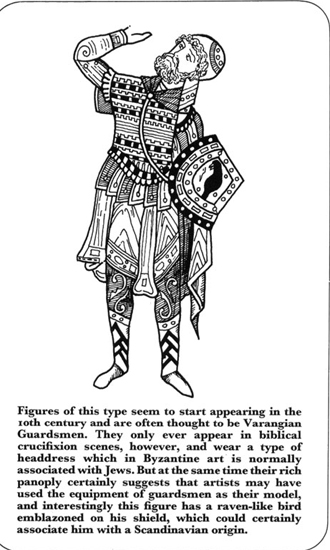
I do not know if this can be trusted, but it is something ...

In this image there are no pteryges at all. The arms are clearly protected by some sort of rerebrace. And the skirt looks to be to be part of the same tunic that covers his arms.
 Attachment: 96.71 KB
Attachment: 96.71 KB
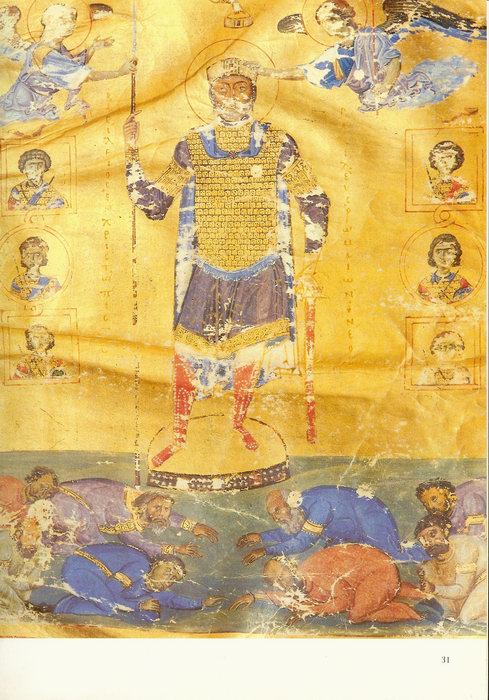

Hi Dan,
The tunic you are referring to is called (chitons).
This dress does not offer any protection. Often, it is worn over a padded suit, this is called (skaramangion).
Note the "Skaramangion" gild leaves to below the tunic and sleeves.
"Skaramangion" to be only military has become in time even a suit of court.
They are two different things.
The "chiton" was often decorated in various colors, red or green or blue but do not know what these colors. Was worn by officers of rank. Many of Byzantine iconography show "Saint warriors".
It is logical that their clothes were those used by the officers.
Note however, that the religious aspect remains, no one has the helmet. This is strange for a warrior. Only, the Joshua's fresco in Greece, is a warrior complete with helmet, even though he was a saint.
I hope it helps. :)
 Attachment: 117.78 KB
Attachment: 117.78 KB
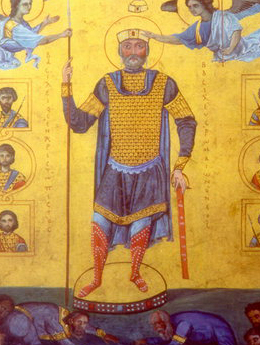
The tunic you are referring to is called (chitons).
This dress does not offer any protection. Often, it is worn over a padded suit, this is called (skaramangion).
Note the "Skaramangion" gild leaves to below the tunic and sleeves.
"Skaramangion" to be only military has become in time even a suit of court.
They are two different things.
The "chiton" was often decorated in various colors, red or green or blue but do not know what these colors. Was worn by officers of rank. Many of Byzantine iconography show "Saint warriors".
It is logical that their clothes were those used by the officers.
Note however, that the religious aspect remains, no one has the helmet. This is strange for a warrior. Only, the Joshua's fresco in Greece, is a warrior complete with helmet, even though he was a saint.
I hope it helps. :)

Last edited by Maurizio D'Angelo on Thu 04 Feb, 2010 3:09 pm; edited 1 time in total
I would have though the other way round. The chiton was put on first. Followed by the skaramangion/kavanion. Folowed by the klivanion. Followed by the epilorikon. Is the blue trim in that illustration part of the klivanion or a glimpse of the skaramangion worn underneath? And how do you know? Is there a primary source listing the order in in which armour is put on?
Regarding the last illustration, it is far better to present the evidence in its original form rather than tamper with it to make it look pretty. That way the reader sees the real evidence without any bias from the restorer.
Regarding the last illustration, it is far better to present the evidence in its original form rather than tamper with it to make it look pretty. That way the reader sees the real evidence without any bias from the restorer.
in order:
1) "klivanion" lamellar
2) "chiton" blue
3) gilded "Skaramangion"
1) "klivanion" lamellar
2) "chiton" blue
3) gilded "Skaramangion"
Why bother guilding the garment if nobody sees it?
I'll ask again. How do you know? Is there a primary source listing the order in in which armour is put on?
I'll ask again. How do you know? Is there a primary source listing the order in in which armour is put on?
I will agree, better originals.
for the sources, here:
THIERRY 2002, sc. 71. = THIERRY N., La Cappadoce de l’antiquité au Moyen Age, Turnhout 2002.
DE CER. I, 125. = REISKE I.I. (ed.), Constantini Porphyrogeniti imperatoris De Cerimoniis Aulae Byzantinae
DE CER. I, 525.
This data is provided by Raffaele D'Amato
also on an Italian magazine of Byzantine studies, but it is only Italian, if you want I can send via e-mail.
something similar can also be seen in this photo:
here there are the pteruges.
The tunic is white,
Skaramangion is green, note the gold embroidery. Could lorikon?? (Mail) I don't know.
 Attachment: 56.44 KB
Attachment: 56.44 KB
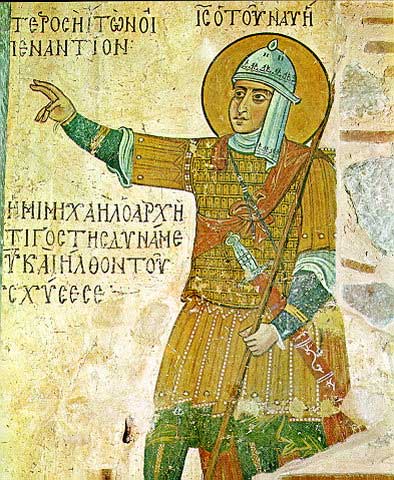
for the sources, here:
THIERRY 2002, sc. 71. = THIERRY N., La Cappadoce de l’antiquité au Moyen Age, Turnhout 2002.
DE CER. I, 125. = REISKE I.I. (ed.), Constantini Porphyrogeniti imperatoris De Cerimoniis Aulae Byzantinae
DE CER. I, 525.
This data is provided by Raffaele D'Amato
also on an Italian magazine of Byzantine studies, but it is only Italian, if you want I can send via e-mail.
something similar can also be seen in this photo:
here there are the pteruges.
The tunic is white,
Skaramangion is green, note the gold embroidery. Could lorikon?? (Mail) I don't know.

That is the problem with relying on illustrations. None of them are photo-realistic. It is impossible to narrrow it down to a single interpretation. You need supporting evidence from other disciplines - surviving texts and/or archaeological finds - to support the interpretation. Otherwise it is pure speculation.
The armour is a different colour to the helmet. Does this mean that it is made of leather or bronze instead of iron? It is gilded in gold? The arms could be part of a long-sleeved padded garment or they could be mail. The skirt at the bottom could be pteryges or they could be splints riveted to a foundation. It might hang from the bottom of the armour or, it could be a separate skirt, or it could be part of the tunic worn underneath. Do pteryges cover the upper arms or are they rerebraces like the earlier illustration? The right arm looks like one and the left arm looks like the other.
The armour is a different colour to the helmet. Does this mean that it is made of leather or bronze instead of iron? It is gilded in gold? The arms could be part of a long-sleeved padded garment or they could be mail. The skirt at the bottom could be pteryges or they could be splints riveted to a foundation. It might hang from the bottom of the armour or, it could be a separate skirt, or it could be part of the tunic worn underneath. Do pteryges cover the upper arms or are they rerebraces like the earlier illustration? The right arm looks like one and the left arm looks like the other.
can be mail is written on wiki ...:wtf: ( that's why the question mark)
Archaeological findings are in support of what I said, found in tombs of the X-XI century in the Crimea.
survived the decorations of this type of layers: the
These decorations had heavy wire gold on a silk red strawberry.
NOVICKAJA-1974
chiton was also called divitision (divisor)
The tunic was also paludamentum grand military parade that was worn
above the Skaramangion as surcoat. Taken with tunic, was dressed as a ceremony for excellence, which
The emperor wore even on his deathbed.
If you know something new I'd like to share with you.
Archaeological findings are in support of what I said, found in tombs of the X-XI century in the Crimea.
survived the decorations of this type of layers: the
These decorations had heavy wire gold on a silk red strawberry.
NOVICKAJA-1974
chiton was also called divitision (divisor)
The tunic was also paludamentum grand military parade that was worn
above the Skaramangion as surcoat. Taken with tunic, was dressed as a ceremony for excellence, which
The emperor wore even on his deathbed.
If you know something new I'd like to share with you.
Last edited by Maurizio D'Angelo on Thu 04 Feb, 2010 6:36 pm; edited 1 time in total
As I write, you do more questions, so, I' m always late ........ :)
the klibanion is gilded gold.
Keep in mind that he is Joshua "the warrior of the faith", is represented by an officer of high rank, I do not think that the warriors were so common. We make a difference.
We know for certain that Athanatoi's klibanion (immortals) was gilded. I do not know whether or gilded or gold. (here I do not know if I am translating my thoughts as well gilded = gold? can I say gilded-gold or gilded-bronze for exsample? )
Nicephorus Phocas (963-969), praecepta Militaria:
...have heavily reinforced iron helmets so as to cover their faces
with mail or flakes of iron two or three layers thick, so that they appear
only their eyes ...
even the fingers of the right hand does not have scale (See thumb) , but it is a fresco, not a photo.
the klibanion is gilded gold.
Keep in mind that he is Joshua "the warrior of the faith", is represented by an officer of high rank, I do not think that the warriors were so common. We make a difference.
We know for certain that Athanatoi's klibanion (immortals) was gilded. I do not know whether or gilded or gold. (here I do not know if I am translating my thoughts as well gilded = gold? can I say gilded-gold or gilded-bronze for exsample? )
Nicephorus Phocas (963-969), praecepta Militaria:
...have heavily reinforced iron helmets so as to cover their faces
with mail or flakes of iron two or three layers thick, so that they appear
only their eyes ...
even the fingers of the right hand does not have scale (See thumb) , but it is a fresco, not a photo.
Last edited by Maurizio D'Angelo on Thu 04 Feb, 2010 6:40 pm; edited 6 times in total
Officers and soldiers there was a difference.
Even among the ranks of a Tagma there was armor difference, the front rows were heavily protected, other less protected.
Their strategy is very different from European cavalry.
I have all the books by Osprey, this is not Osprey's design.
question: where David Nicolle says what you said above? In what book and page?
Here: designed a Cataphract, but those who must settle the battle formation called "triangular" as Nicephorus describes in great detail.
Kataphraktoi X-XI century
 Attachment: 102.97 KB
Attachment: 102.97 KB
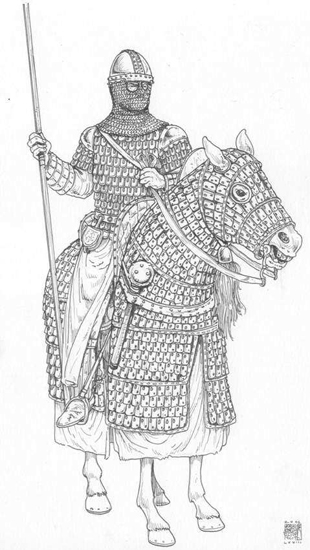
copyright Giorgio Albertini
Even among the ranks of a Tagma there was armor difference, the front rows were heavily protected, other less protected.
Their strategy is very different from European cavalry.
I have all the books by Osprey, this is not Osprey's design.
question: where David Nicolle says what you said above? In what book and page?
Here: designed a Cataphract, but those who must settle the battle formation called "triangular" as Nicephorus describes in great detail.
Kataphraktoi X-XI century

copyright Giorgio Albertini
| Maurizio D'Angelo wrote: |
| Officers and soldiers there was a difference.
Even among the ranks of a Tagma there was armor difference, the front rows were heavily protected, other less protected. Their strategy is very different from European cavalry. I have all the books by Osprey, this is not Osprey's design. question: where David Nicolle says what you said above? In what book and page? Here: designed a Cataphract, but those who must settle the battle formation called "triangular" as Nicephorus describes in great detail. Kataphraktoi X-XI century |
This is great. Thanks for your patience. I haven't cited anything from Nicolle. I don't really trust him as a source. I don't really trust D'Amato either after his latest book about Roman armour. His photos are great but his claims about Roman leather armour are heavily biased and unsupportable even using his own evidence. He places way way too much emphasis on iconographical evidence and ignores any interpretation that doesn't fit his pet theories.
Dan a question: do you think a klivanion could be pierced by an arrow. There are studies in this regard?
I think not, since I discovered how they were willing to strip, but maybe you know me more.
I think not, since I discovered how they were willing to strip, but maybe you know me more.
| Maurizio D'Angelo wrote: |
| Dan a question: do you think a klivanion could be pierced by an arrow. There are studies in this regard?
I think not, since I discovered how they were willing to strip, but maybe you know me more. |
Short answer - I doubt it but haven't seen any studies
A slightly longer answer would be the same regardless of which armour was being discussed. The chances of an arrow penetrating under battlefield conditions is not high enough to affect the outcome of a battle. It would have happened on occasion but it wouldn't have been worn if it wasn't effective.
It may be a little offtopic here, yet continuing the question about the Byzatine armours - for some time I was wondering about the face protection of the Byzantine warriors. I noticed that, apart from varangian guard and sassanid warriors, most of them were unprotected, wearing only mail on the back of their heads.
For some time I am very willing to reenact a 10th century Byzantine warrior, but i still have few gaps, I am unable to fill.
As in my country, reenacting battles are far more brutal than those in the west, I need to have much better protection to sustain the damage. For instance, we are not omitting heads as our targets, so sometimes the face is accidentally hit. That is why I need face protection that is lacking in the materials I have about Byzantine armament.
Yet once I found a trace of very interesting face protection with chainmail on the picture I have attached to this post. Does anyone know how true is that thing those blue riders have under their helmets:
 Attachment: 113.01 KB
Attachment: 113.01 KB
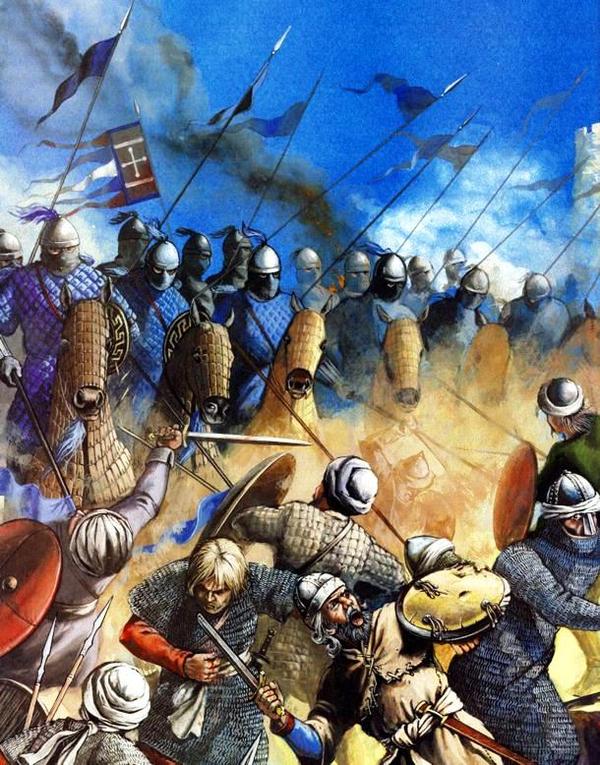
For some time I am very willing to reenact a 10th century Byzantine warrior, but i still have few gaps, I am unable to fill.
As in my country, reenacting battles are far more brutal than those in the west, I need to have much better protection to sustain the damage. For instance, we are not omitting heads as our targets, so sometimes the face is accidentally hit. That is why I need face protection that is lacking in the materials I have about Byzantine armament.
Yet once I found a trace of very interesting face protection with chainmail on the picture I have attached to this post. Does anyone know how true is that thing those blue riders have under their helmets:

I have seen such kind of maille ski-masks on a few statutes. There was a thread about it here on myArmoury not too long ago. But I have no idea what year they were from and if they would be appropriate for Byzantine warriors.
Page 1 of 2
You cannot post new topics in this forumYou cannot reply to topics in this forum
You cannot edit your posts in this forum
You cannot delete your posts in this forum
You cannot vote in polls in this forum
You cannot attach files in this forum
You can download files in this forum
All contents © Copyright 2003-2006 myArmoury.com — All rights reserved
Discussion forums powered by phpBB © The phpBB Group
Switch to the Full-featured Version of the forum
Discussion forums powered by phpBB © The phpBB Group
Switch to the Full-featured Version of the forum